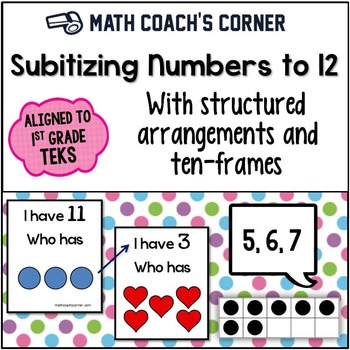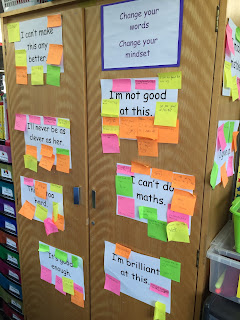Math Mondays
For early Elementary grades, students should learn and articulate how to break apart and put together numbers. What parts make that number? Here is a great video from Kindergarten Teacher Stephanie Latimer Quick Images: Visualizing Number Combinations found on the Teaching Channel. In this video, the teacher makes her own ten frame on a whiteboard and uses magnets which she can easily change around on the ten frame.
To practice subitizing or know the quantity without thinking, teachers can help students practice by showing the students a ten frame with a specific number of dots. They then ask the students, "How many did you see?" and "How did you see them?". Ask several students, give wait time, prompt students to articulate how they saw the amount shown...did they count each dot individually, count by twos, group dots...? Have students come up and show the class how they arrived at their answer. Wrap up by showing the ten frame and restating the the purpose. Have this be a daily five minute routine with three different cards each time.
A fun game that helps to that build number sense for early Elementary students is "Two Fisted Pennies" where students practice solving addition problems with a missing addend.
- Choose a target number and count out that number of pennies together.
- Player A hides some of the pennies in one hand and shows the other pennies in the other hand.
- Player B looks at the pennies showing and calls out how many pennies are hidden.
From the Mrs. Jump's class, here are some addition games to build number sense using manipulatives. Although this packet does have a monetary cost, reading through this site you can find lots of great ideas at no cost.
 |
| Math Coach's Corner Math games |
From Math Coach's Corner, there is a free I Have/Who Has and Ten-Frame Flash cards.
| Ten Flashing Fireflies Template/Book |
Also found at her website are free templates for Making Ten: Ten Flashing Fireflies to go along with the book Ten Flashing Fireflies written by Philemon Sturgis.
Another great Math game is Top-it! There are several variations for this game: Number Top-it, Addition Top-it, Subtraction Top-it, Multiplication Top-it, 2-Digit Number Top-it, and Fraction Top-it.
For Number Top-it: Shuffle a deck of cards and place face down between the players. Each player turns over a card and reads it out loud. The player with the higher number must say, "Eight is more than three" or "Eight is greater than three" (if this terminology has been introduced). That player claims the cards for that round. If there is a tie, players can just flilp another card. (Note: Because students often struggle with the concept of Less, play the game the same way but the player with the smaller number wins.)
For Addition Top-it: Each player draws two numbers and says the equation out loud (i.e.: three and seven are ten). In order to claim the cards for that round, the player with the higher sum then must say, "10 is more than 6." (Don't forget to play the game with the version where the player with a smaller sum claims the cards.)
Thank you for visiting, Tricia
















